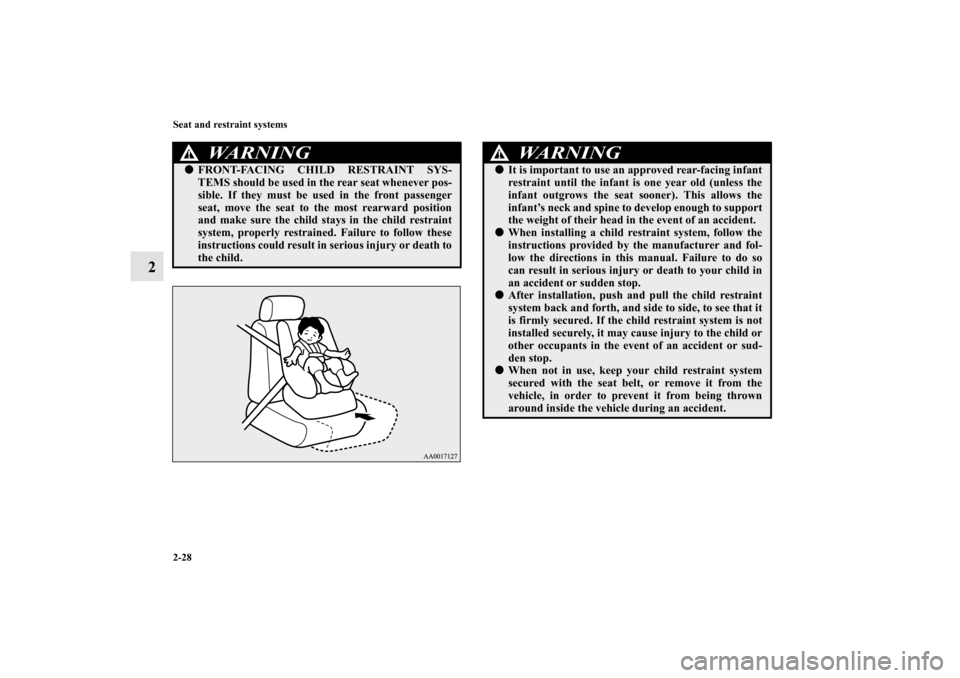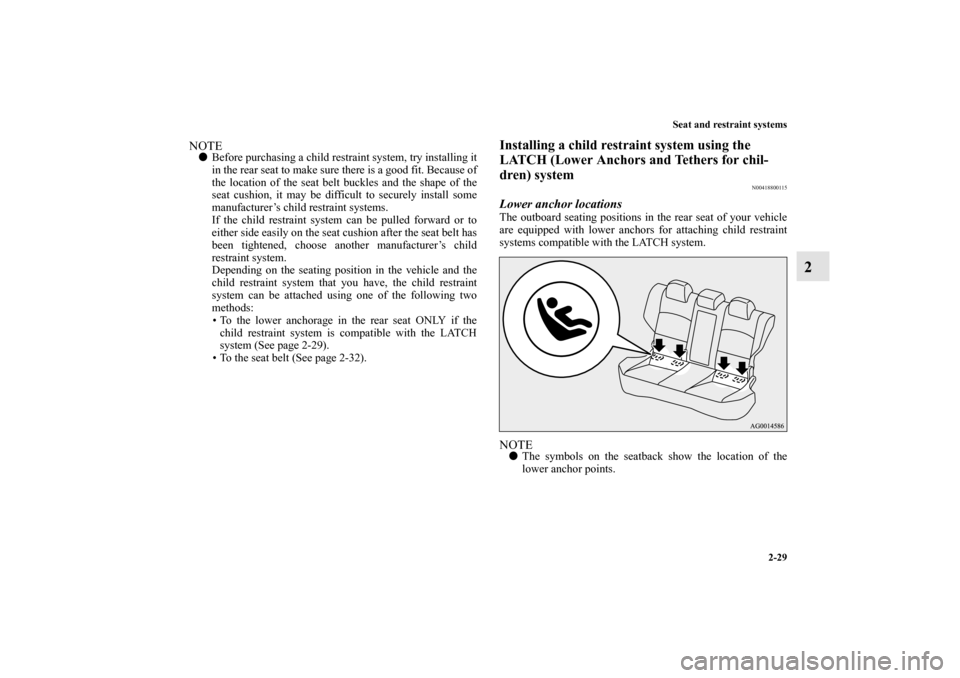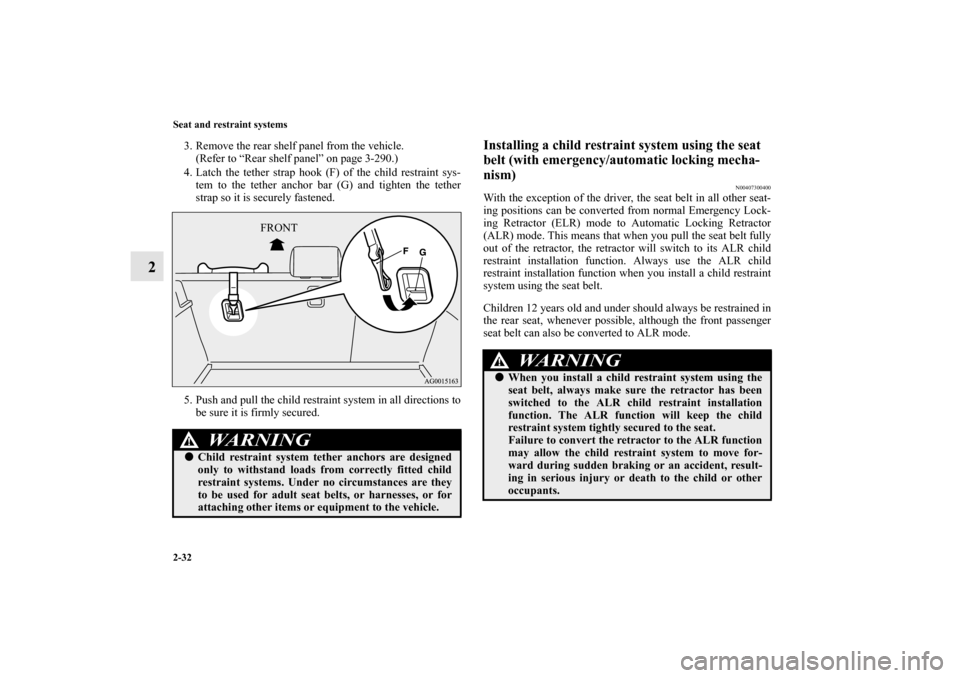Page 51 of 658
2-18 Seat and restraint systems
2
2. Grasp the latch plate and slide it up the webbing so that it
easily pulls across your body. 3. Pull the seat belt out slowly while holding the latch plate.
Push the latch plate into the buckle until you hear a
“click”. Pull up on the belt to be sure the latch plate is
locked securely in the buckle.
NOTE�
If the seat belt locks up and cannot be pulled out, pull it
once with force and let it retract all the way.
Then, pull the belt out slowly once again.
BK0103001US.book 18 ページ 2009年8月20日 木曜日 午前10時45分
Page 53 of 658

2-20 Seat and restraint systems
2
Seat belt warning
N00409100011
Driver’s seat belt reminder/warning light and display
N00409200025
Warning light
Warning display type 1
Warning display type 2
A tone and warning light are used to remind the driver to fasten
the seat belt.
If the ignition switch is turned to the “ON” position without the
driver’s seat belt being fastened, a warning light will come on
and a tone will sound for approximately 6 seconds to remind
you to fasten your seat belt.
If you then drive with the seat belt unfastened for longer than a
minute from when the ignition switch was turned on, the warn-
ing light will come on and blink repeatedly and the tone will
sound intermittently.
The warning light and the tone will stop after approximately 90
seconds.If you then repeatedly stop and start your vehicle with the seat
belt unfastened, the warning light/display and tone will remind
you to fasten your seat belt every time the vehicle starts mov-
ing. You will also be reminded to fasten your seat belt in this
way when you remove your seat belt while driving. The warn-
ing light and the tone go off when the seat belt is fastened.
NOTE�
At the same time, “FASTEN SEAT BELT” will be dis-
played on the information screen in the multi-information
display.
WA R N I N G
!�
In order to reduce the risk of serious injury or death
in an accident, always wear your own seat belt. Do
not allow anyone to ride in your vehicle unless he or
she is also seated and wearing a seat belt. Children
should additionally be restrained in a secure child
restraint system.
BK0103001US.book 20 ページ 2009年8月20日 木曜日 午前10時45分
Page 55 of 658

2-22 Seat and restraint systems
2
Seat belt extender
N00406700087
When your seat belt, even fully extended, is not long enough, a
seat belt extender must be obtained. The extender may be used
for either of the front seats.
WA R N I N G
!�
Always adjust the shoulder belt anchor so that the
shoulder belt is positioned across the center of your
shoulder without touching your neck. The shoulder
belt should not be able to fall off your shoulder. Fail-
ure to follow this instruction can adversely affect
seat belt performance and increase the risk of seri-
ous injury or death in the event of an accident.
�
Adjust the shoulder belt anchor only when the vehi-
cle is not in motion.
�
Make sure the anchor is securely locked in position
after adjusting it.
WA R N I N G
!�
The extender should only be used if the existing belt
is not long enough. Anyone who can use the stan-
dard seat belt should not use an extender. Unneces-
sary use of an extender can adversely affect seat belt
performance in an accident.
�
When not required, the extender must be removed
and stowed.
BK0103001US.book 22 ページ 2009年8月20日 木曜日 午前10時45分
Page 61 of 658

2-28 Seat and restraint systems
2
WA R N I N G
!�
FRONT-FACING CHILD RESTRAINT SYS-
TEMS should be used in the rear seat whenever pos-
sible. If they must be used in the front passenger
seat, move the seat to the most rearward position
and make sure the child stays in the child restraint
system, properly restrained. Failure to follow these
instructions could result in serious injury or death to
the child.
WA R N I N G
!�
It is important to use an approved rear-facing infant
restraint until the infant is one year old (unless the
infant outgrows the seat sooner). This allows the
infant’s neck and spine to develop enough to support
the weight of their head in the event of an accident.
�
When installing a child restraint system, follow the
instructions provided by the manufacturer and fol-
low the directions in this manual. Failure to do so
can result in serious injury or death to your child in
an accident or sudden stop.
�
After installation, push and pull the child restraint
system back and forth, and side to side, to see that it
is firmly secured. If the child restraint system is not
installed securely, it may cause injury to the child or
other occupants in the event of an accident or sud-
den stop.
�
When not in use, keep your child restraint system
secured with the seat belt, or remove it from the
vehicle, in order to prevent it from being thrown
around inside the vehicle during an accident.
BK0103001US.book 28 ページ 2009年8月20日 木曜日 午前10時45分
Page 62 of 658

Seat and restraint systems
2-29
2
NOTE�
Before purchasing a child restraint system, try installing it
in the rear seat to make sure there is a good fit. Because of
the location of the seat belt buckles and the shape of the
seat cushion, it may be difficult to securely install some
manufacturer’s child restraint systems.
If the child restraint system can be pulled forward or to
either side easily on the seat cushion after the seat belt has
been tightened, choose another manufacturer’s child
restraint system.
Depending on the seating position in the vehicle and the
child restraint system that you have, the child restraint
system can be attached using one of the following two
methods:
To the lower anchorage in the rear seat ONLY if the
child restraint system is compatible with the LATCH
system (See page 2-29).
To the seat belt (See page 2-32).
Installing a child restraint system using the
LATCH (Lower Anchors and Tethers for chil-
dren) system
N00418800115
Lower anchor locationsThe outboard seating positions in the rear seat of your vehicle
are equipped with lower anchors for attaching child restraint
systems compatible with the LATCH system.NOTE�
The symbols on the seatback show the location of the
lower anchor points.
BK0103001US.book 29 ページ 2009年8月20日 木曜日 午前10時45分
Page 63 of 658
2-30 Seat and restraint systems
2
Tether anchor locations
N00418900145
Your vehicle has 3 attachment points located on the back of the
seatbacks. These are for securing a child restraint system tether
strap to each of the 3 rear seating positions in your vehicle.
Examples of child restraint systems compatible with the
LATCH system
N00419000185
A- Rear-facing child restraint system
B- Front-facing child restraint system
C- Child restraint system lower anchor connectors
D- Tether strap
(These are only examples.)
BK0103001US.book 30 ページ 2009年8月20日 木曜日 午前10時45分
Page 64 of 658

Seat and restraint systems
2-31
2
Using the LATCH system
N00419100199
1. In order to securely fasten the tether strap, remove the
head restraint from the location where you wish to install
the child restraint system.
2. Push the anchor connectors (A) on the child restraint sys-
tem into the slits (B) in accordance with the instructions
provided by the child restraint system manufacturer.
Remember, the lower anchors (E) provided with your
vehicle are designed to secure suitable child restraint sys-
tems compatible with the LATCH system in the rear seat
only.
NOTE�
In order to secure a child restraint system compatible with
the LATCH system, use the lower anchor points in the
outboard positions of the rear seat. It is not necessary to
use the vehicle’s seat belt. The vehicle’s seat belt, how-
ever, MUST be used to secure a child restraint system in
the center position of the rear seat.
A- Connector D- Vehicle seat cushion
B- Slit E- Lower anchor
C- Vehicle seatback
WA R N I N G
!�
If there is any foreign material in or around the
lower anchors, remove it before installing the child
restraint system. Also, make sure the seat belt is
away from, not looped through or otherwise inter-
fering with, the child restraint system. If foreign
matter is not removed and/or the seat belt interferes
with the child restraint system, the child restraint
system will not be secured properly, could detach
and move forward in the event of sudden braking or
an accident, and could result in injury to the child or
other vehicle occupants.
�
When the vehicle is moving, do not adjust the seat
where the child restraint system is installed.
BK0103001US.book 31 ページ 2009年8月20日 木曜日 午前10時45分
Page 65 of 658

2-32 Seat and restraint systems
2
3. Remove the rear shelf panel from the vehicle.
(Refer to “Rear shelf panel” on page 3-290.)
4. Latch the tether strap hook (F) of the child restraint sys-
tem to the tether anchor bar (G) and tighten the tether
strap so it is securely fastened.
5. Push and pull the child restraint system in all directions to
be sure it is firmly secured.
Installing a child restraint system using the seat
belt (with emergency/automatic locking mecha-
nism)
N00407300400
With the exception of the driver, the seat belt in all other seat-
ing positions can be converted from normal Emergency Lock-
ing Retractor (ELR) mode to Automatic Locking Retractor
(ALR) mode. This means that when you pull the seat belt fully
out of the retractor, the retractor will switch to its ALR child
restraint installation function. Always use the ALR child
restraint installation function when you install a child restraint
system using the seat belt.
Children 12 years old and under should always be restrained in
the rear seat, whenever possible, although the front passenger
seat belt can also be converted to ALR mode.
WA R N I N G
!�
Child restraint system tether anchors are designed
only to withstand loads from correctly fitted child
restraint systems. Under no circumstances are they
to be used for adult seat belts, or harnesses, or for
attaching other items or equipment to the vehicle.
FRONT
WA R N I N G
!�
When you install a child restraint system using the
seat belt, always make sure the retractor has been
switched to the ALR child restraint installation
function. The ALR function will keep the child
restraint system tightly secured to the seat.
Failure to convert the retractor to the ALR function
may allow the child restraint system to move for-
ward during sudden braking or an accident, result-
ing in serious injury or death to the child or other
occupants.
BK0103001US.book 32 ページ 2009年8月20日 木曜日 午前10時45分